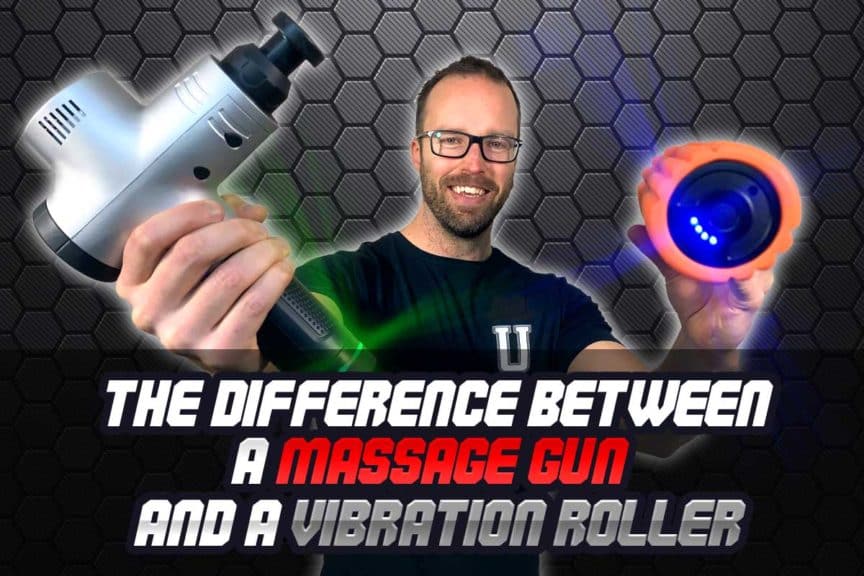With technology continually advancing at blistering speeds, the health and fitness world is producing some unique and beneficial recovery methods that are rising in popularity. The problem is that sometimes there can be a seemingly overwhelming amount of overlap between these different products that are all claiming to do what sound like similar things.
One such prominent example is the difference between massage guns and vibrating foam rollers. Are they more or less the same? Or are they really in two different categories when it comes to their health and recovery benefits?
While massage guns and vibrating foam rollers have different application techniques, the benefits that they offer along with how those benefits are achieved are largely similar. Both rely largely on vibration to enhance blood flow, reduce muscle tension and provide therapeutic pain relief.
This is not to say that the two are exactly the same in terms of how they achieve their therapeutic benefits, rather that it’s their underlying principles that are quite similar. So, if you’re interested in gaining the upper hand when it comes to the finer details between these two devices as well as which one may be a better option for you, keep on reading!
To help you save time, you can use the article headlines below to instantly navigate to that section of the article. These are quick links, so simply click (or tap) on the following article headlines to jump to that particular section.
ARTICLE OVERVIEW
- What’s the premise behind vibration therapy?
- What does the science behind vibration therapy say?
- How are massage guns and vibrating foam rollers similar to one another?
- Unique features and benefits of using a massage gun
- Unique features and benefits of using a vibrating roller
- How to determine which device is likely best for you
- Final thoughts
Related Article: IASTM: Here’s How it Works to Decrease Pain and Improve Mobility
What’s the premise behind vibration therapy?
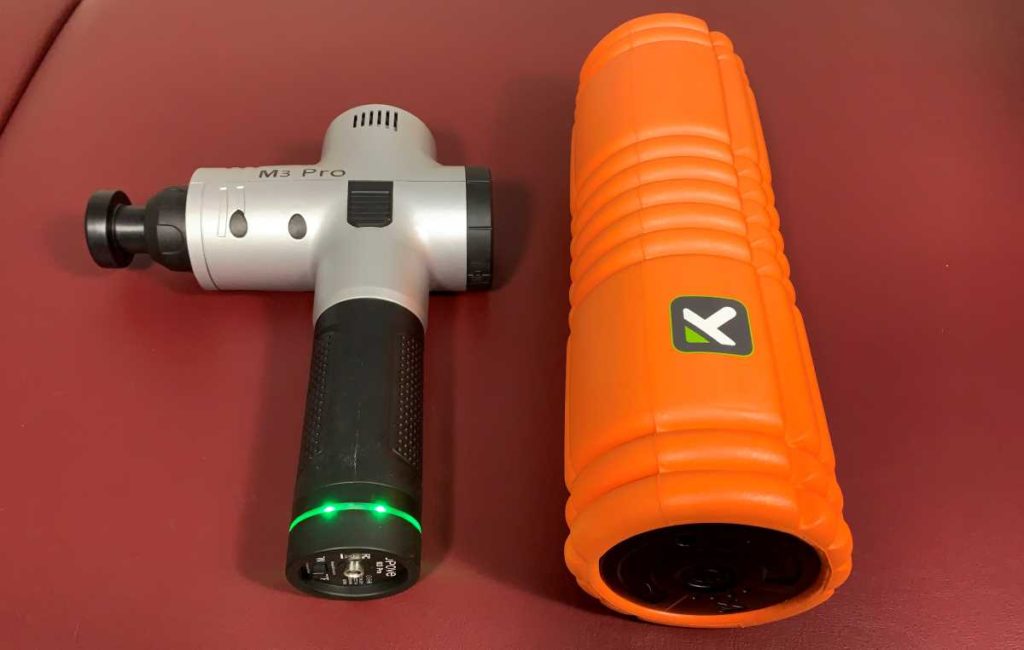
Though each of the devices look incredibly different, the premise behind how each one delivers therapeutic pain relief and relaxation are quite similar; both use vibrations/oscillations emitted by the device as a means to provide anabolic mechanical signals to bone, muscles and tendons. The results are the production of favorable environments for these tissues, leading to increases such as bone mineral density, local blood flow into muscles to the targeted area and decreases muscle soreness.
This improvement of localized blood flow around and into the targeted muscular tissues enhances the warmth of the area, which helps muscle tissues to relax, oftentimes generating a pain-relief phenomenon. When tissues are warm, the tissues are able to move a bit more freely/in a more relaxed manner.
Related article: The Kabuki Boomstick: Why it’s Worth Getting
Think of how you feel when you get out of a warm bath – the body tends to feel looser, more relaxed and experience less discomfort. This is what happens to the area being treated by the massage gun or vibrating roller, just on a more local scale than when compared to submerging yourself in a bathtub.
The end result with either of the two devices is that you’ll be able to perform a bit better before your physical activity, recover a bit quicker after your physical activity and keep tissues happier and healthier when using them in general.
What does the science behind vibration therapy say?
When it comes to vibration therapy, science tends to look at two different ways in which it can be performed; it can either be performed to the entire body at one time (often referred to as whole body vibration therapy) or to one area of the body (often referred to as local vibration therapy). And when it comes to the results, there is a decent amount of literature that supports its use for various applications.
It’s worth mentioning that using a vibrating roller constitutes as a form of local vibration therapy, as whole body vibration training tends to be done with large, expensive vibration plates or vibration machines.
Click any of the links below to read the particular study in reference:
In terms of orthopedic-based measurements, whole body vibration therapy has been found to be beneficial for:
- Improving leg muscle strength in older adults (1)
- Preventions of delayed onset muscle soreness (DOMS) following workouts (2)
- Increased muscle oxygenation (3)
- Improved whole body mobility in elderly patients (4)
- Improving balancing ability in elderly women (4)
And when it comes to local vibration therapy, favorable orthopedic-based outcomes have been found for:
- Prevention of delayed onset muscle soreness (DOMS) following workouts (5)
- Significant reduction in calf pain and gluteal pain in male recreational runners (6)
- Speeding recovery on ankle injuries and hamstring muscle strains (7)
This is just the very tip of the iceberg in terms of what exists in the established literature for vibration therapy’s positive effects on the musculoskeletal system. It’s certainly a fascinating topic to read up on, so if you happen to be a geek like me, you just might find that the more you read into this topic, the more excited you get about its potentially favourable applications in regards to helping various populations live healthier, pain-free lives.
How are massage guns and vibrating foam rollers similar to one another?
In case you’re wondering, my vibrating roller of choice is the Grid Vibe Plus by TriggerPoint (link takes you to Amazon). My massage device of choice is the Opove M3 Pro, which is no longer on Amazon (which is a bummer since it’s pretty stellar for the price). But if you’re looking for something with thousands of five-star reviews with the same cost of the Opove, you could check out the Mebak massage device (Amazon link), which seems pretty stellar as well.
Please note: I receive very small commissions at no extra cost to you when purchasing from Amazon. These commissions help to offset the costs associated with hosting and operating this website.
Regardless of the type or model of vibrating roller or massage gun, there are some pretty similar features that they tend to share. Here’s a brief rundown on some of the more key similarities:
You can use them before, during or after activities
For starters, it’s good to know that each of these devices can be beneficial either before a physical activity, during an activity or afterwards. It’s also good to know that you don’t have to be an athlete in order to use one.
When it comes to more effectively preparing parts of the body for an upcoming activity session, these devices can be (and often are) used as a means to help enhance an individual’s warmup. A better warmup means that the body is not only more adequately prepared for the upcoming physical activity (thus enhancing performance), but also that the likelihood of sustaining an injury is greatly reduced.
Related article: Faster Exercise Recovery: How to Remove Lactic Acid After a Workout
Each of these devices is also commonly used as a means to enhance physical recovery after a workout or physical activity session. Vibration or percussion to the muscles that have just undergone rigorous movement demands will allow elevated blood flow and oxygen delivery to those tissues, which can help with sustaining an ideal environment for recovery.
Additionally, this increased rate and extent of blood flow will also help flush out some of the metabolic junk that has built up within the muscle following the activity. This ultimately means that you can get quicker muscle recovery along with less soreness following your activity session.
As well, either of these two types of devices can also be used outside of training windows as a means to continue to promote tissue health and wellness. This ultimately means that there really isn’t a wrong time to use either of them and that they therefore both lend themselves quite nicely to treating sore, tight tissues regardless of whether you’re an athlete or average joe.
Variable intensity settings
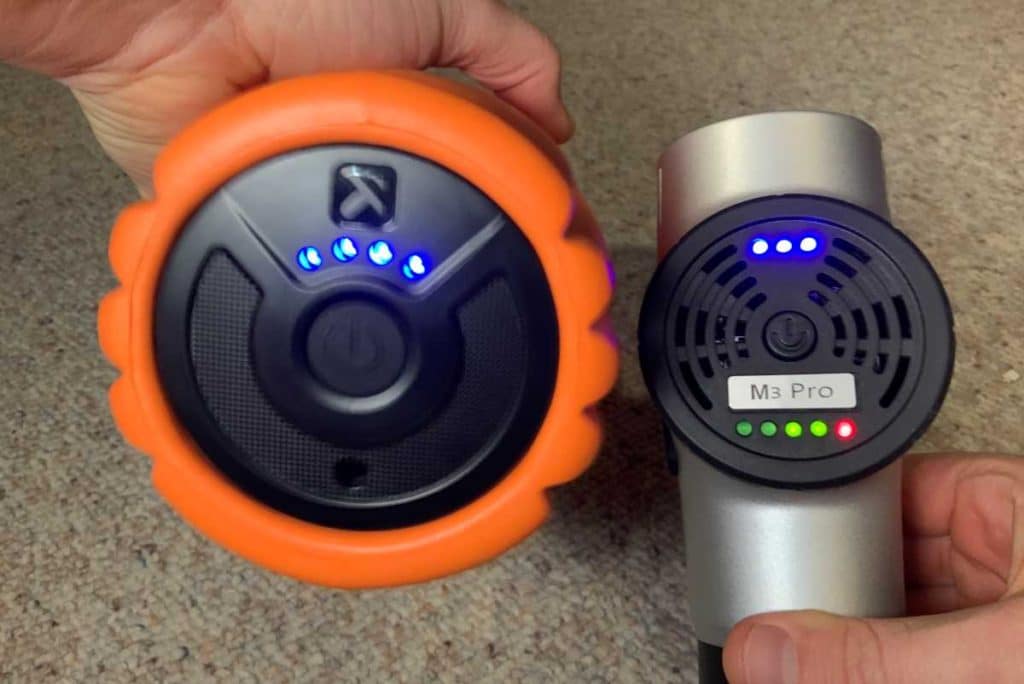
Pretty much every massage gun that I’m aware of as well as every vibrating roller that I’m aware of all have the ability to adjust the intensity of their power output. While how this is specifically achieved for each device may slightly differ, all of these devices have the ability to select a low, medium or high-power setting.
Some devices offer this feature in more steps or increments than just these three settings, but it’s a pretty universal feature to have at least three power settings to choose from. This is quite a nice feature to have since different individuals may require different output settings based on unique, individual factors such as tissue sensitivity, body part being targeted, desired therapeutic response, etc.
And of course, since they both have power settings, this means that they both are battery powered, meaning you’ll need to charge them from time to time. As with many other battery-powered devices these days, vibration rollers and massage guns generally come with their own charging brick/cable when you purchase them.
Portability
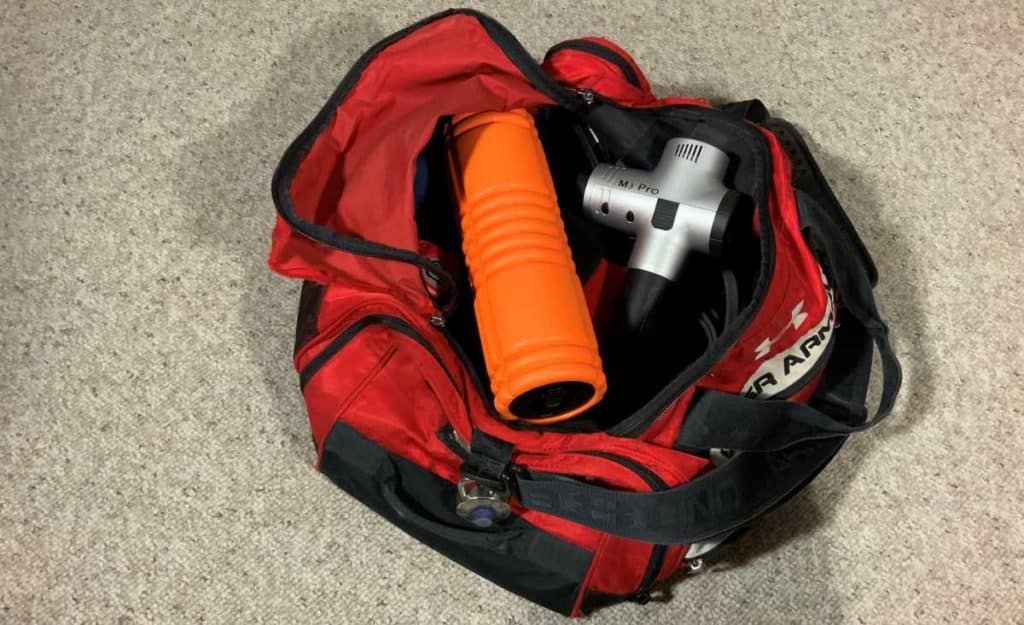
Another great feature of each of these therapeutic devices is that they are both highly portable. Portability is a nice feature to have for a number of reasons. For starters, it means that you can use these devices in the gym before a workout, in the park after an outdoor workout, at home or just about anywhere else you could think of.
Not that it’s a competition between the two, but each of these devices are super portable, meaning that it’s pretty much a tie if trying to decide which one may be better for transporting around; they take up about the same size of space and weigh about the same so I wouldn’t say that there is a clear winner here.
So, rest assured that you can toss either into your gym bag without taking up tons of valuable space or making your gym bag uncomfortably heavy to carry around.
Unique features and benefits of using a massage gun
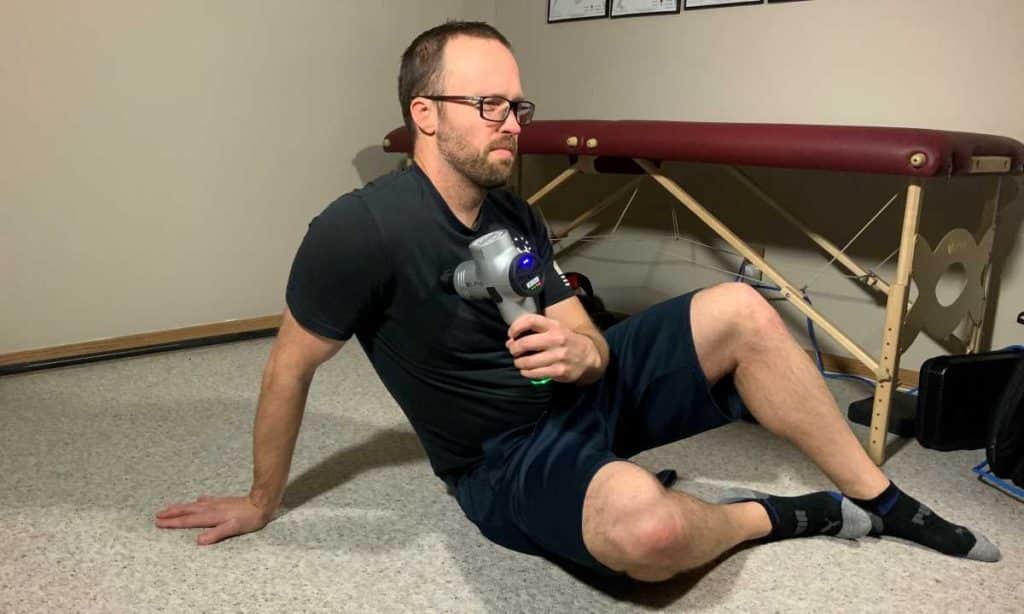
The massage gun gets its chance to shine when it comes to having a bit more treatment versatility than the vibrating roller. For starters, most massage guns come with variable application tips that can be swapped out based on individual preference and/or the area of the body being treated.
In addition to the treatment versatility, you tend to also have much more precision over the ares(s) you wish to treat. While vibrating rollers can still have decent precision for treating different body parts, the precision offered by massage guns is not only higher, but generally less cumbersome or tedious to achieve as well; simply put the application tip on the sore spot you wish to treat and you’re off to the races.
Unique features and benefits of using a vibrating roller

Where the vibrating roller tends to shine over a massage gun is when it comes to getting larger areas treated much more quickly. Since a larger area of the body is often in contact with the roller, the result tends to be more tissue stimulation in less time. This is why the actual amount of precision over a smaller area may be a bit difficult with the roller, however the trade off is that if you’re looking to treat/relax a larger area, the roller may be more ideal.
Quick bonus tip: The vibrating roller is awesome for treating your calves since you can have both calves laying on the roller at the same time, saving you a lot of time when it comes to the need for treating both. Since the calves are often a tight/sore area on many people (especially runners), being able to crank out some super time-efficient and effective sessions for these muscles on a regular basis is a pretty awesome feature.
How to determine which device is likely best for you
In an ideal world, most people would likely find it quite nice to have both of these devices. However, we don’t always live in an ideal world. And since there is a bit of a financial cost to each of these devices, it’s oftentimes best to invest in just one of these devices.
Determining which one may be best for you will come down to a few different factors pertaining to your unique needs.
From a financial standpoint, both of these devices cost approximately the same amount of money. At the time of writing this article, the massage gun that I personally use myself, the Opove M3 Pro, is no longer avaialble on Amazon, which is a bummer cause I have been very happy with mine.
If you’re in the market for a rather similar one, you could consider this Mebak device, (Link takes you to Amazon) which costs pretty much the same as my Opove and has tons and tons of great reviews.
Related article: Why You Shouldn’t Spend Tons of Money on IASTM Tools
The Grid Vibe Plus can also be found through various websites online for somewhere around $100 (USD). The Grid Vibe Plus (Link takes you to Amazon) is my personal vibrating roller of choice, though just like massage guns, there are a ton of different brands on the market. Just like my Opove M3 Pro, I feel that the Grid Vibe Plus strikes a great balance point between cost and quality.
Picking the right one for you
If you’re trying to figure out which is likely the best purchase for you, the first question to ask yourself is which part or parts of your body you plan on treating. If you plan on treating only one part of your body, such as your legs, you might not need as much versatility than if you plan on treating all parts of your body.
Personally, I generally find it easier to treat the backside of my body with a vibrating roller, as there’s nothing I have to hold onto and it’s much easier to get the backside of my legs (glutes, hamstrings & calves). Sometimes with a massage gun I find that are just some areas that I can’t reach on myself or are challenging to hold the gun for when attempting to treat.
Conversely, if you like having more focal or precise control over treating multiple areas, a massage gun may be the ticket; not only do most massage guns come with different attachment heads based on areas that you’re treating, but since their treatment heads are much smaller, there’s a precision factor that can come into play, which may or may not be a handy feature for you.
Another handy feature of using the roller is that you don’t have to hold onto anything while using it. Holding onto a massage gun sometimes becomes tiring on the hand/arm when self-treating for extended periods of time or when having to hold the device in a challenging position or unique angle in order to get a hard to reach area of your body, as I just previously mentioned.
My personal recommendation
If you plan on largely treating the backside of your body, the vibrating roller is likely the way to go. But if you really see yourself only treating a few key spots that are easy to reach when treating yourself, a massage gun may be more practical, especially considering the different attachment heads you can use, based on your needs or preferences.
Either way, either of these two therapeutic devices should be a great piece of arsenal to have in your “treatment tool kit”, be it for self treatment or for helping others. If you’re still not sure as to which may be the better of the two for yourself, see if you can ask around your social circle for anyone who has either of these devices and if they’d be willing to let you try it for yourself. It’s always nice to have extra peace of mind when purchasing equipment of any type.
Final thoughts
If you’re wondering what the differences are between a massage gun and a vibrating roller, it’s worth knowing that they are largely similar in terms of how they achieve therapeutic muscle relaxation and reduction in pain; they both use vibration into the targeted muscle(s) as a means to improve blood flow, enhance tissue mobility and help you feel better overall.
Where they largely differ is in their treatment application; the massage gun is handheld and tends to be able to be more precise with the treatment area whereas the roller will target a broader area while allowing you to keep both of your hands free throughout the process.
Both can be great therapeutic pieces of equipment to utilize for self-treatment purposes, with each having their distinct pros and cons. These pros and cons will largely depend on your own individual needs and therapeutic goals. Which one will be best for you will ultimately come down to your intended outcomes and preferences, so it’s worth giving this some thought if you’re in the market for only purchasing one of these two great therapeutic devices.
References:
1. Lau RW, Liao L-R, Yu F, Teo T, Chung RC, Pang MY. The effects of whole body vibration therapy on bone mineral density and leg muscle strength in older adults: a systematic review and meta-analysis. Clin Rehabil. 2011;25(11):975–988.
2. Veqar Z, Imtiyaz S. Vibration therapy in management of delayed onset muscle soreness (DOMS). J Clin Diagn Res JCDR. 2014;8(6):LE01.
3. Manimmanakorn N, Ross JJ, Manimmanakorn A, Lucas SJ, Hamlin MJ. Effect of whole-body vibration therapy on performance recovery. Int J Sports Physiol Perform. 2015;10(3):388–395.
4. Bautmans I, Van Hees E, Lemper J-C, Mets T. The feasibility of whole body vibration in institutionalised elderly persons and its influence on muscle performance, balance and mobility: a randomised controlled trial [ISRCTN62535013]. BMC Geriatr. 2005;5(1):1–8.
5. Imtiyaz S, Veqar Z, Shareef MY. To compare the effect of vibration therapy and massage in prevention of delayed onset muscle soreness (DOMS). J Clin Diagn Res JCDR. 2014;8(1):133.
6. Broadbent S, Rousseau JJ, Thorp RM, Choate SL, Jackson FS, Rowlands DS. Vibration therapy reduces plasma IL6 and muscle soreness after downhill running. Br J Sports Med. 2010;44(12):888–894.
7. Peer KS, Barkley JE, Knapp DM. The acute effects of local vibration therapy on ankle sprain and hamstring strain injuries. Phys Sportsmed. 2009;37(4):31–38.

Hi! I’m Jim Wittstrom, PT, DPT, CSCS, Pn1.
I am a physical therapist who is passionate about all things pertaining to strength & conditioning, human movement, injury prevention and rehabilitation. I created StrengthResurgence.com in order to help others become stronger and healthier. I also love helping aspiring students and therapists fulfill their dreams of becoming successful in school and within their clinical PT practice. Thanks for checking out my site!

